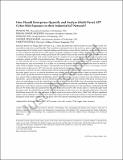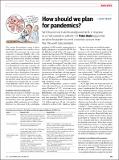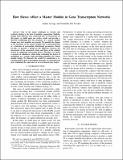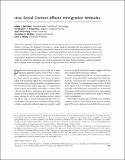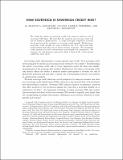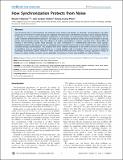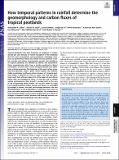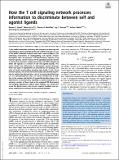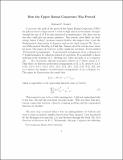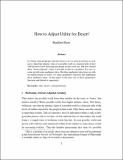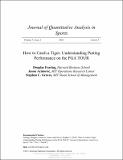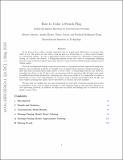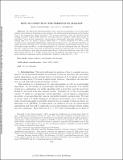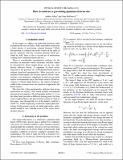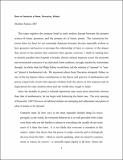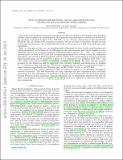Browsing MIT Open Access Articles by Title
Now showing items 21833-21852 of 55825
-
How Should Enterprises Quantify and Analyze (Multi-Party) APT Cyber-Risk in their Industrial IoT Network?
Industrial Internet of Things (IIoT) networks (e.g., a smart grid industrial control system) are increasingly on the rise, especially in smart cities around the globe. They contribute to meeting the day-to-day needs (e.g., ... -
How should we plan for pandemics?
(BMJ Publishing Group, Ltd., 2009-09)WHO has revised its definition of pandemic flu in response to current experience with A/H1N1. Peter Doshi argues that our plans for pandemics need to take into account more than the worst case scenarios The current flu ... -
How slaves affect a master module in gene transcription networks
(Institute of Electrical and Electronics Engineers (IEEE), 2013-12)One of the major challenges in systems and synthetic biology is the lack of modular composition. Modules change their behavior once connected, due to retroactivity. In this paper, we build upon our earlier results and ... -
How social capital helps communities weather the COVID-19 pandemic
(Public Library of Science (PLoS), 2021-01)Why have the effects of COVID-19 been so unevenly geographically distributed in the United States? This paper investigates the role of social capital as a mediating factor for the spread of the virus. Because social capital ... -
How Social Context Affects Immigration Attitudes
(University of Chicago Press, 2022) -
How Sovereign Is Sovereign Credit Risk?
(American Economic Association, 2011-04)We study the nature of sovereign credit risk using an extensive set of sovereign CDS data. We find that the majority of sovereign credit risk can be linked to global factors. A single principal component accounts for 64 ... -
How Synchronization Protects from Noise
(Public Library of Science, 2009-01)The functional role of synchronization has attracted much interest and debate: in particular, synchronization may allow distant sites in the brain to communicate and cooperate with each other, and therefore may play a ... -
How telemedicine integrated into China’s anti-COVID-19 strategies: case from a National Referral Center
(BMJ, 2020-08)Introduction: We present the integration of telemedicine into the healthcare system of West China Hospital of Sichuan University (WCH), one of the largest hospitals in the world with 4300 inpatient beds, as a means for ... -
How temporal patterns in rainfall determine the geomorphology and carbon fluxes of tropical peatlands
(National Academy of Sciences (U.S.), 2017-06)Tropical peatlands now emit hundreds of megatons of carbon dioxide per year because of human disruption of the feedbacks that link peat accumulation and groundwater hydrology. However, no quantitative theory has existed ... -
How the news media activate public expression and influence national agendas
(American Association for the Advancement of Science (AAAS), 2017-11)We demonstrate that exposure to the news media causes Americans to take public stands on specific issues, join national policy conversations, and express themselves publicly—all key components of democratic politics—more ... -
How the T cell signaling network processes information to discriminate between self and agonist ligands
(Proceedings of the National Academy of Sciences, 2020)© 2020 National Academy of Sciences. All rights reserved. T cells exhibit remarkable sensitivity and selectivity in detecting and responding to agonist peptides (p) bound to MHC molecules in a sea of self pMHC molecules. ... -
How the Upper Bound Conjecture Was Proved
(Springer-Verlag, 2014-07)We give a short history of how the Upper Bound Conjecture for Spheres was proved. -
How to adjust utility for desert
(Taylor & Francis, 2011-06)It is better when people get what they deserve. So we need an axiology according to which the intrinsic value of a possible world is a function of both how well-off and how deserving the people in that world are. But how ... -
How to Catch a Tiger: Understanding Putting Performance on the PGA TOUR
(Walter de Gruyter, 2011-01)Existing performance metrics utilized by the PGA TOUR have biases towards specific styles of play, which make relative player comparisons challenging. Our goal is to evaluate golfers in a way that eliminates these biases ... -
How to Color a French Flag: Biologically Inspired Algorithms for Scale-Invariant Patterning
(Springer International Publishing, 2020)© 2020, Springer Nature Switzerland AG. In the French flag problem, initially uncolored cells on a grid must differentiate to become blue, white or red. The goal is for the cells to color the grid as a French flag, i.e., ... -
How to Compute in the Presence of Leakage
(Society for Industrial & Applied Mathematics (SIAM), 2015-10)We address the following problem: how to execute any algorithm P, for an unbounded number of executions, in the presence of an adversary who observes partial information on the internal state of the computation during ... -
How to construct a gravitating quantum electron star
(American Physical Society, 2013-09)Motivated by the holographic study of Fermi surfaces, we develop methods to solve Einstein gravity coupled to fermions and gauge fields, with anti–de Sitter boundary conditions and a chemical potential. -
How to Construct a Poem: Descartes, Sidney
(Manchester University Press, 2013)This essay explores the intimate bond in early modern Europe between the premier science of forms, geometry, and the premier art of forms, poetry. The connections between these (at least for us) seemingly disparate ... -
HOW TO DISTINGUISH BETWEEN CLOUDY MINI-NEPTUNES AND WATER/VOLATILE-DOMINATED SUPER-EARTHS
(IOP Publishing, 2013-12)One of the most profound questions about the newly discovered class of low-density super-Earths is whether these exoplanets are predominately H2-dominated mini-Neptunes or volatile-rich worlds with gas envelopes dominated ...

